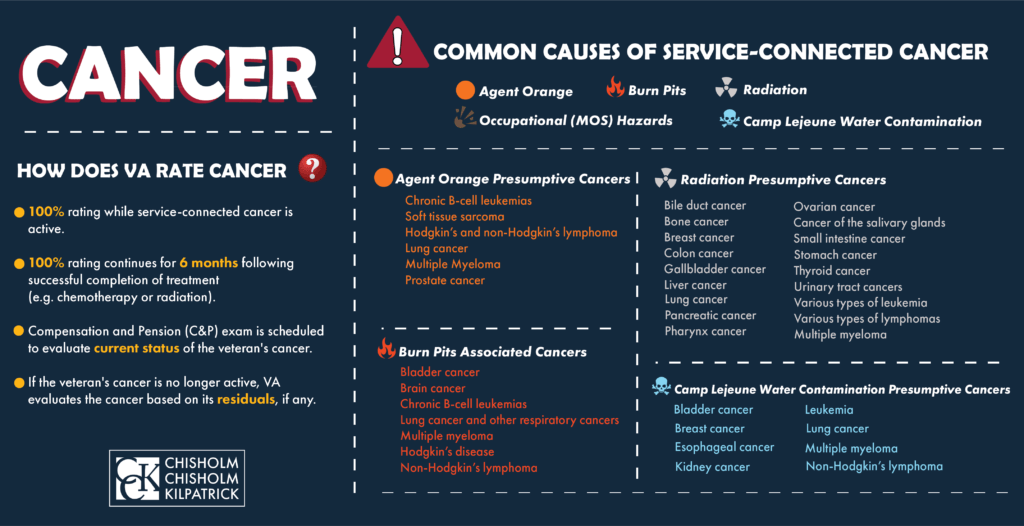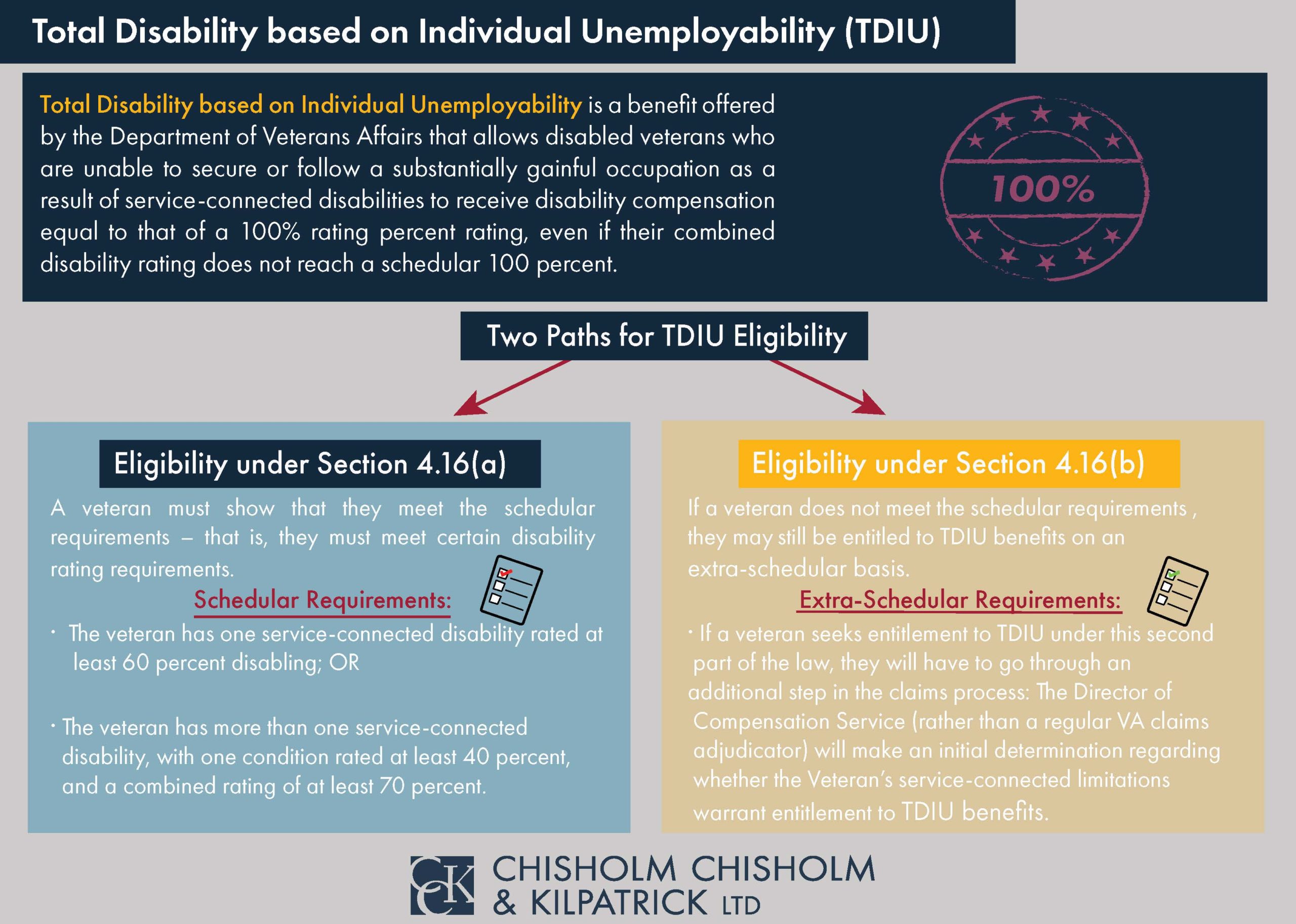VA Disability Ratings for Small Cell Carcinoma

CCK Law: Our Vital Role in Veterans Law
What is Small Cell Carcinoma?
Small cell lung cancer is a type of cancer that most commonly occurs in the lung. In this form of cancer, malignant cells form in the tissues of the lung. The lungs are two organs that make up the respiratory system and make it possible for a person to properly breathe.
There are two types of small cell lung cancer: small cell carcinoma, or oat cell cancer, and combined cell carcinoma. Small cell lung cancer can grow very rapidly, but is far less common than other forms, as it only accounts for about 13 percent of all lung cancer cases per year in the United States.
One complication with small cell lung cancer is that it can often spread quickly to other parts of the body, such as the lymph nodes in the chest.
Symptoms of Small Cell Carcinoma
- Chest pain
- Persistent Cough
- Difficulty breathing
- Wheezing
- Coughing up blood
- Hoarse voice
- Difficulty swallowing
- Weight loss, or loss of appetite
- Exhaustion
- Swelling, specifically in the face and neck
Diagnosing and Treating Small Cell Carcinoma
As mentioned above, small cell carcinoma is often not found until it has grown rapidly and spread in the body. To diagnose small cell carcinoma, various tests may be performed. Specifically, a doctor may perform a physical examination and inquire into the person’s medical history. Laboratory tests are used to determine the presence of cancer cells, which can include testing samples of tissue, blood, urine, or other substances.
X-rays of the chest can be used to examine the internal organs, as well as CT, or CAT, scans. Additionally, a biopsy, or a sampling of cells or tissue, may be analyzed to determine if cancer cells are present. Specialists also gain information by studying a person’s spit in some instances, particularly when mucus is coughed up from the lungs.
Certain risk factors can make a person more susceptible to developing small cell carcinoma. These risk factors include if a person smokes or has been exposed to secondhand smoke. Additionally, this type of cancer can be caused by exposure to radon, asbestos, or other cancer-causing agents such as uranium, diesel exhaust, or other inhaled chemicals like arsenic, beryllium, cadmium, or mustard gas. Air pollution also poses a major risk factor, one that a person often cannot control.
There are also many factors that can determine what form of treatment is used. These factors can include the person’s age, gender, and overall health, as well as the stage to which the cancer has progressed. Sometimes multiple treatments may concurrently help to treat the cancer.
VA Service Connection for Small Cell Carcinoma
Generally, approval for VA disability benefits requires three things:
- An in-service event, injury, or illness;
- A current diagnosis by a medical professional;
- A medical nexus, or link, between your in-service event, injury, or illness and your current diagnosis.
The most crucial part of a claim for service connection for lung cancer is to connect the lung cancer diagnosis to the veteran’s military service. There are multiple ways this may be done:
Primary Service Connection—This form of service connection can be achieved if there is evidence that the veteran’s service directly caused their lung cancer.
Secondary Service Connection—This form of service connection can be achieved if the veteran’s lung cancer developed as a result of another service-connected condition. This could also apply if a veteran’s service-connected lung condition caused them to develop another condition, in which case that second condition may be eligible for secondary service connection.
Presumptive Service Connection—In some instances, the connection between a veteran’s lung cancer and their service may be presumptive, meaning that the burden of proof is not on the veteran to indicate that their service caused their lung cancer. Usually, in order to qualify for this form of service connection, a veteran will need to have served in a specific location and time period.
To support the veteran’s claim for service connection, the veteran may submit lay evidence. Lay evidence, or lay statements, can be written by the veteran or anyone who knows the veteran and can speak to their condition. Importantly, lay evidence may also be submitted by fellow service members.

Compensation and Pension (C&P) Exams for Small Cell Carcinoma
Once a claim has been filed, VA may request a Compensation and Pension exam, or C&P exam. This exam will usually be performed by a VA physician or VA contracted physician who may physically examine the veteran, as well as ask questions regarding the veteran’s military service, their small cell carcinoma, or symptoms of their small cell carcinoma.
To schedule a C&P exam, VA will usually call the veteran or send them a letter. As such, it is crucial to ensure that VA has the veteran’s most up-to-date contact information. If VA does not, the veteran might miss a C&P request. If a veteran fails to attend an exam, or fails to reschedule one they have missed, their claim could be denied.
Prior to the exam, the examiner should review the veteran’s c-file. The c-file will usually contain any documentation that has previously been submitted to VA, as well as the veteran’s medical and military service records.
The veteran may also use a DBQ, or Disability Benefits Questionnaire, to bolster their claim. A Disability Benefits Questionnaire is a form created by VA that the veteran may use to address important aspects of their condition, such as symptoms, severity, possible causes, and relation to other disabilities. The veteran may also have their private doctor fill out a DBQ for them.
There are many different doctors who may treat someone for small cell carcinoma, such as a medical oncologist, a pulmonologist, a radiation oncologist, or a thoracic surgeon. As such, any one of these specialists could fill out a DBQ for the veteran and provide insight into the veteran’s small cell carcinoma for VA.
VA Ratings for Small Cell Carcinoma
If a veteran is service-connected for an active cancer, VA should automatically assign a 100 percent disability rating. This rating will continue as long as the veteran’s cancer is active.
After six months following the veteran’s successful treatment program, which can include chemotherapy, radiation, or surgery, VA will schedule the veteran for a C&P exam to re-evaluate their condition. If the veteran’s cancer is in remission, then VA will evaluate the cancer based on its residuals.
Toxic Exposure and Small Cell Carcinoma
As discussed above, various forms of toxic exposure veterans have faced during their military service may have resulted in the development of small cell carcinoma. While some of these exposures do have presumptive service connection, others do not.
Radiation Exposure
“Atomic Veterans” are veterans who participated in “radiation-risk activity.” According to VA, veterans who served in the following locations may have been exposed to ionizing radiation:
- Occupation of Hiroshima and Nagasaki, Japan from August 6, 1945 and July 1, 1946
- Prisoners of War (POWs) in Japan during World War II
- Participants in atmospheric nuclear weapons tests, primarily conducted in Nevada and the Pacific Ocean from 1945 to 1962
- Underground nuclear weapons testing in Amchitka Island, Alaska prior to January 1, 1974
- Any of the following gaseous diffusion plants for at least 250 days prior to February 1, 1991:
- Paducah, Kentucky
- Portsmouth, Ohio
- K25 in Oak Ridge, Tennessee
- “Worked as an x-ray technician, in a reactor plant, or in nuclear medicine or radiography”
- “Did tasks like those of a Department of Energy (DoE) employee that makes them a member of the Special Exposure Cohort”
Additional circumstances in which veterans may have been exposed include:
- The Fukushima nuclear accident in Japan from March 12 to May 11, 2011
- The U.S. Air Force plutonium clean-up mission in Palomares, Spain
- Exposure to depleted uranium
- Exposure to radiation from Long Range Navigation stations (LORAN) from 1942 to 2010
- McMurdo Station, Antarctica nuclear power plant from 1964 to 1973
VA offers a free Ionizing Radiation Registry health exam to certain veterans who may have been exposed to ionizing radiation.
Various cancers, including lung cancer, have been linked to ionizing radiation exposure. Therefore, if a veteran served in one of the above locations, and developed small cell carcinoma as a result, they can become service-connected on a presumptive basis.
Presumptive service connection means that VA will presume a veteran’s condition is the result of their in-service exposure to ionizing radiation and will not require that the veteran provide a medical nexus linking their condition to the exposure.

Agent Orange Exposure
Lung cancer has also been connected to Agent Orange exposure. Agent Orange is one of several herbicides, or “rainbow herbicides,” that were used during the Vietnam War era. Specifically, Agent Orange was a mixture of two different kinds of highly toxic chemicals: 2, 4-D and 2, 4, 5-T. The highly toxic dioxin contaminant known as 2, 3, 7, 8-TCDD is a byproduct that is produced by Agent Orange. Many veterans came into contact with Agent Orange, including those who served in areas other than Vietnam.
The Institute of Medicine of the National Academy of Science, Engineering, and Medicine concluded in its 1994 report “Veterans and Agent Orange: Health Effects of Herbicides Used in Vietnam” and in future updates that there is “limited/suggestive evidence of an association” between exposure to herbicides (2,4-D; 2,4,5-T and its contaminant TCDD; cacodylic acid; and picloram) and respiratory cancers. As a result, VA added respiratory cancers to the list of presumptive conditions related to Agent Orange exposure.

Military Burn Pit Exposure
Military burn pits are large areas of land in which the military and its contractors incinerated all waste generated by military bases. The United States Military used burn pits as part of its waste disposal protocol in places such as Iraq and Afghanistan in the post-9/11 era.
The practice was effective in reducing large quantities of waste, but the pits emitted plumes of toxic smoke which were later found to cause damaging health effects. Materials such as human and medical waste, plastic, rubber, petroleum, and ammunition were disposed of in burn pits.
Unlike Agent Orange exposure, there is currently no presumptive service connection for veterans exposed to burn pits. Since there is no presumption, VA adjudicates burn pit claims on a case-by-case basis.
As of 2021, there are several major bills currently pending in the Senate, and one in the House of Representatives, that deal with the toxic exposure caused by burn pits. These bills include:
- Conceding Our Veterans’ Exposure Now and Necessitating Training Act (COVENANT)
- Presumptive Benefits for War Fighters Exposed to Burn Pits and Other Toxins Act of 2021
- Veterans Burn Pit Exposure Recognition Act
- Toxic Exposure in the American Military Act (TEAM)
Any of these bills, if passed, would offer much-needed relief to veterans suffering the toxic effects of burn pit exposure.
Specifically, the COVENANT Act would make any form of respiratory cancer a presumptive condition for veterans who were exposed to burn pits. As small cell carcinoma is a form of lung cancer, it would therefore qualify as respiratory cancer. If this were to pass, veterans would only need to provide evidence that they were exposed to burn pits, thus placing less of the burden of proof on the veteran.

Denied VA Disability Benefits for Small Cell Carcinoma?
Small cell carcinoma is a condition that has been linked to multiple forms of exposure, yet it is not a presumptive condition for every form of exposure it has been linked to—specifically military burn pits. As such, claims for small cell carcinoma can often be difficult and may get denied. However, a denial does not mean the end of the road.
Our experienced VA disability attorneys may be able to help you secure VA disability benefits for small cell carcinoma. Contact our office today for a free consultation at 800-544-9144.
About the Author
Share this Post


